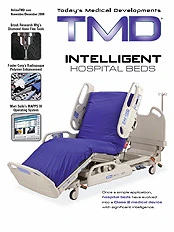
In an increasingly virtual world, the ability to simulate touch delivers powerful advantages - for example, allowing an online shopper to feel a shirt fabric. Enter the discipline of haptics: the use of robotics with sophisticated feedback and controls to simulate a tactile experience for the user. Haptic device manufacturer Quanser Consulting Inc., for example, produces 5- and 6-axis robots that supply crisp, realistic sensations. To do so, they leverage proprietary hardware and software, along with hightorque, high-bandwidth motors from MicroMo Electronics Inc.
Quanser builds general haptic devices for research. Their most recent design is the High Definition Haptic Device (HD2), a parallel mechanism with six degrees of freedom. Formed of two five-bar linkages coupled together, the low-friction, mechanicallybalanced robot offers high resolution motion in a large workspace. The HD2 offers ±90° of motion on roll and pitch, and ±180° in yaw.
DESIGNING FOR TOUCH
"Whatever you are trying to simulate - it can be knocking on wood, it can be brain surgery - the haptics of it have to feel crisp and smooth," says Paul Karam, Quanser's manager of dynamics and control. "The mechanism has to be able to render the true feel of the surgery or it is not beneficial." An ideal haptics device exhibits low friction and low inertia while generating force with a high dynamic range and all within a large work envelope. To achieve this, Quanser takes a mechatronics approach in their design, doing extensive modeling and testing in advance of prototyping to determine the best approach. To maximize responsiveness in the HD2, for example, the engineering team located the motors in the housing rather than on the actuator arm itself.
Keys to performance are Quanser's linear current amplifiers. "You get very smooth, even forces around zero you can actually feel," Karam says. "You cannot do that with a pulse-width modulated (PWM) amplifier." The design team also avoids standard motion controllers. Generating the sensation of touching a hard surface or interacting with the environment requires very high bandwidth forces with negligible latency. The delays introduced by a standard motion controller are unacceptable. Instead, the engineering team leveraged Quanser's eight-port data acquisition boards and proprietary controls software QuaRC.
The result is a PC-based controller that operates at 1kHz to 10kHz, simultaneously reading the encoders, calculating the kinematics of the device, and generating torques on all six motors.
Part of mechatronic design is taking a systems-level approach to design, not just arbitrarily choosing components.
"That is where our collaborative work with MicroMo comes in," Karam says. "Using their high-end motors with our linear amplifiers, we are getting motors that are capable of generating high output torque, but at the same time very low friction and stiction, and very low perceived inertia. Coupling our technologies with MicroMo's has brought our haptic devices to the forefront of the field." Quanser continues to work with OEMs and researchers alike. With its design platform and MicroMo motors, the company can quickly and easily turn concept into product. "If a surgeon comes to us and says they want to study needle insertion in operating rooms, we can design a device that has the right specifications," Karam explains. "We have a good working relationship with MicroMo where we consistently go to them for new products and new motors. We know how to interface easily with their motors and encoder packages. There is no reason we cannot work with them on future products endlessly."
MicroMo Electronics Inc.
Clearwater, FL
micromo.com
Quanser Consulting Inc.
Markham, Ontario, Canada
quanser.com

Explore the November December 2009 Issue
Check out more from this issue and find your next story to read.
Latest from Today's Medical Developments
- Pioneering battery-free cardiac implants
- KBC Tools & Machinery marks its 60th anniversary, Founder’s Day
- Address the challenges of machining high-temperature aerospace components
- Elevate your manufacturing operations with April’s Manufacturing Lunch + Learn
- AdvaMed statement on tariff announcement
- Collets – Not all are created equal
- ENGEL expands production capacities in the Americas; new plant opened in Mexico
- MFI brings fast, high-polishing additive parts finishing to Rapid + TCT 2025







